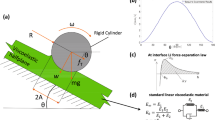Abstract
When a frictional interface is subject to a localized shear load, it is often (experimentally) observed that local slip events propagate until they arrest naturally before reaching the edge of the interface. We develop a theoretical model based on linear elastic fracture mechanics to describe the propagation of such precursory slip. The model’s prediction of precursor lengths as a function of external load is in good quantitative agreement with laboratory experiments as well as with dynamic simulations, and provides thereby evidence to recognize frictional slip as a fracture phenomenon. We show that predicted precursor lengths depend, within given uncertainty ranges, mainly on the kinetic friction coefficient, and only weakly on other interface and material parameters. By simplifying the fracture mechanics model, we also reveal sources for the observed nonlinearity in the growth of precursor lengths as a function of the applied force. The discrete nature of precursors as well as the shear tractions caused by frustrated Poisson’s expansion is found to be the dominant factors. Finally, we apply our model to a different, symmetric setup and provide a prediction of the propagation distance of frictional slip for future experiments.






Similar content being viewed by others
References
Rubinstein, S., Cohen, G., Fineberg, J.: Dynamics of precursors to frictional sliding. Phys. Rev. Lett. 98(22), 226103 (2007). doi:10.1103/PhysRevLett.98.226103
Maegawa, S., Suzuki, A., Nakano, K.: Precursors of global slip in a longitudinal line contact under non-uniform normal loading. Tribol. Lett. 38(3), 313 (2010). doi:10.1007/s11249-010-9611-7
Scheibert, J., Dysthe, D.K.: Role of friction-induced torque in stick-slip motion. Europhys. Lett. 92(5), 54001 (2010). doi:10.1209/0295-5075/92/54001
Trømborg, J., Scheibert, J., Amundsen, D., Thøgersen, K., Malthe-Sørenssen, A.: Transition from static to kinetic friction: insights from a 2D model. Phys. Rev. Lett. 107(7), 074301 (2011). doi:10.1103/PhysRevLett.107.074301
Bouchbinder, E., Brener, E.A., Barel, I., Urbakh, M.: Slow cracklike dynamics at the onset of frictional sliding. Phys. Rev. Lett. 107(23), 235501 (2011). doi:10.1103/PhysRevLett.107.235501
Amundsen, D.S., Scheibert, J., Thøgersen, K., Trømborg, J., Malthe-Sørenssen, A.: 1D model of precursors to frictional stick-slip motion allowing for robust comparison with experiments. Tribol. Lett. 45(2), 357 (2012). doi:10.1007/s11249-011-9894-3
Kammer, D.S., Yastrebov, V.A., Spijker, P., Molinari, J.F.: On the propagation of slip fronts at frictional interfaces. Tribol. Lett. 48(1), 27 (2012). doi:10.1007/s11249-012-9920-0
Otsuki, M., Matsukawa, H.: Systematic breakdown of Amontons’ law of friction for an elastic object locally obeying Amontons’ law. Sci. Rep. 3, 1586 (2013). doi:10.1038/srep01586
Lapusta, N., Rice, J.R.: Nucleation and early seismic propagation of small and large events in a crustal earthquake model. Geophys J. Res. Solid Earth 108(B4) (2003). doi:10.1029/2001JB000793
Wu, Y., Chen, X.: The scale-dependent slip pattern for a uniform fault model obeying the rate-and state-dependent friction law. J. Geophys. Res. Solid Earth 119(6), 4890 (2014). doi:10.1002/2013JB010779
Rubinstein, S.M., Cohen, G., Fineberg, J.: Cracklike processes within frictional motion: is slow frictional sliding really a slow process? MRS Bull. 33(12), 1181 (2008). doi:10.1557/mrs2008.249
Freund, L.B.: The mechanics of dynamic shear crack propagation. J. Geophys. Res. Solid Earth 84(B5), 2199 (1979). doi:10.1029/JB084iB05p02199
Ampuero, J.P., Ripperger, J., Mai, P.M.: In: Abercrombie, R., McGarr, A., Di Toro, G., Kanamori, H. (eds.) Earthquakes: Radiated Energy and the Physics of Faulting, pp. 255–261. American Geophysical Union, Washington, DC (2006). doi:10.1029/170GM25
Kato, N.: Fracture energies at the rupture nucleation points of large interplate earthquakes. Earth Planet. Sci. Lett. 353–354(0), 190 (2012). doi:10.1016/j.epsl.2012.08.015
Svetlizky, I., Fineberg, J.: Classical shear cracks drive the onset of dry frictional motion. Nature 509, 205 (2014). doi:10.1038/nature13202
Palmer, A.C., Rice, J.R.: The growth of slip surfaces in the progressive failure of over-consolidated clay. Proc. R. Soc. Lond. A 332(1591), 527 (1973). doi:10.1098/rspa.1973.0040
Andrews, D.: Rupture propagation with finite stress in antiplane strain. J. Geophys. Res. 81(20), 3575 (1976). doi:10.1029/JB081i020p03575
Braun, O., Barel, I., Urbakh, M.: Dynamics of transition from static to kinetic friction. Phys. Rev. Lett. 103(19), 194301 (2009). doi:10.1103/PhysRevLett.103.194301
Kaneko, Y., Ampuero, J.P.: A mechanism for preseismic steady rupture fronts observed in laboratory experiments. Geophys. Res. Lett. 38(21), L21307 (2011). doi:10.1029/2011GL049953
Bar Sinai, Y., Brener, E.A., Bouchbinder, E.: Slow rupture of frictional interfaces. Geophys. Res. Lett. 39(3), L03308 (2012). doi:10.1029/2011GL050554
Bar-Sinai, Y., Spatschek, R., Brener, E.A., Bouchbinder, E.: On the velocity-strengthening behavior of dry friction. J. Geophys. Res. Solid Earth 119(3), 1738 (2014). doi:10.1002/2013JB010586
Radiguet, M., Kammer, D.S., Gillet, P., Molinari, J.F.: Survival of heterogeneous stress distributions created by precursory slip at frictional interfaces. Phys. Rev. Lett. 111(16), 164302 (2013). doi:10.1103/PhysRevLett.111.164302
Radiguet, M., Kammer, D.S., Molinari, J.F.: The role of viscoelasticity on heterogeneous stress fields at frictional interfaces. Mech. Mater. 80, 276 (2015). doi:10.1016/j.mechmat.2014.03.009
Freund, L.: Dynamic Fracture Mechanics. Cambridge University Press, New York (1990)
Tada, H., Paris, P.C., Irwin, G.R.: The Stress Analysis of Cracks Handbook, 3rd edn. ASME, New York (2000)
Rice, J.R.: In: Kelly, R. (ed.): Proceedings of the Eighth U.S. National Congress of Applied Mechanics. Western Periodicals Co., North Hollywood, California, pp. 191–216 (1979)
Uenishi, K., Rice, J.R.: Universal nucleation length for slip-weakening rupture instability under nonuniform fault loading. J. Geophys. Res. 108(B1), B12042 (2003). doi:10.1029/2001JB001681
Garagash, D.I., Germanovich, L.N.: Nucleation and arrest of dynamic slip on a pressurized fault. J. Geophys. Res. 117(B10), B10310 (2012). doi:10.1029/2012JB009209
Ciccotti, M., Mulargia, F.: Differences between static and dynamic elastic moduli of a typical seismogenic rock. Geophys. J. Int. 157(1), 474 (2004). doi:10.1111/j.1365-246X.2004.02213.x
Ben-David, O., Cohen, G., Fineberg, J.: The dynamics of the onset of frictional slip. Science 330(6001), 211 (2010). doi:10.1126/science.1194777
Weertman, J.: Unstable slippage across a fault that separates elastic media of different elastic constants. J. Geophys. Res. 85(B3), 1455 (1980). doi:10.1029/JB085iB03p01455
Acknowledgments
The research described in this article is supported by the European Research Council (ERCstg UFO-240332) and the Swiss National Science Foundation (grant PMPDP2-145448). JPA was funded by US NSF (grant EAR-1015704).
Author information
Authors and Affiliations
Corresponding author
Rights and permissions
About this article
Cite this article
Kammer, D.S., Radiguet, M., Ampuero, JP. et al. Linear Elastic Fracture Mechanics Predicts the Propagation Distance of Frictional Slip. Tribol Lett 57, 23 (2015). https://doi.org/10.1007/s11249-014-0451-8
Received:
Accepted:
Published:
DOI: https://doi.org/10.1007/s11249-014-0451-8




